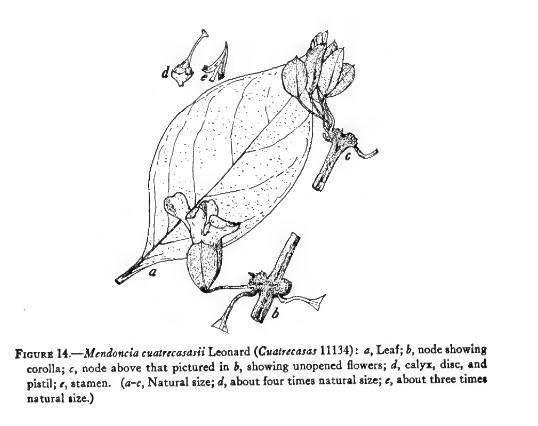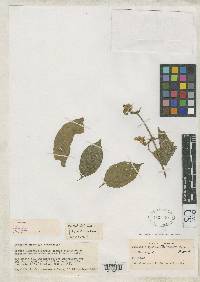
Neotropical Flora
|
Family: Acanthaceae
|
23. Mendoncia cuatrecasasii Leonard, sp. nov. FIGURE 14 Herba vel suffrutex volubilis, caulibus subteretibus, glabris vel minute strigosis; lamina foliorum oblongo-ovata vel oblonga, apice acuminata, basi angustata, in petiolum decurrens, chartacea, glabra vel in costa et venis lateralibus minute strigosa; flores fasciculati; bracteae ellipticae utrinque rotundatae, apice mucronatae, extus minute strigosae, intus glabrae; corolla subflava, extus glabra, lobis intus ex parte puberulis; stamina barbata; calyx subhyalinus, erosus; stylus et ovarium et discus glabri. Herbaceous or suffrutescent vines; stems subterete, glabrous or in- conspicuously and minutely strigose; leaf blades oblong-ovate to oblong, short-acuminate at apex (the tip blunt and often mucronate), narrowed at base and decurrent on the petiole, drying yellowish brown, firm, glabrous, or the costa and lateral veins (4 pairs) inconspicuously and closely strigose; petioles up to 2 cm. long, glabrous or minutely strigose; flowers usually about 10, borne on short fan-shaped spurs, these axillary or terminating the short branches; pedicels about 1 cm. long, minutely strigose; bracts elliptic, 8 to 10 mm. long, 6 to 7 mm. wide, rounded at both ends, apiculate at apex, inconspicuously strigose, the hairs minute and closely appressed; corolla yellowish white, glabrous without, 2 cm. long, the tube 5 to 10 mm. long, the limb oblique, the lobes rounded, about 5 mm. long, an oblique lateral area of the inner surface of each lobe papillose-puberulous; calyx subhya- line, erose; style and ovary glabrous; fruit not seen. Type in the National Herbarium of Colombia, collected along the San Miguel River, in damp forest of Quebrada de la Hormiga, Comi- saría of Putumayo, Colombia, altitude 290 meters, December 17, 1940, by J. Cuatrecasas (No. 11134). Fragment of type in the U. S. National Herbarium, No. 1830082. Mendoncia cuatrecasasii is related to M. glomerata Leonard but dif- fers in certain well-marked characters. In M. cuatrecasasii the leaf blades are oblong-ovate to oblong instead of strictly ovate; they are firm, drying yellowish brown, instead of being thin and drying dark brown as in M. glomerata. The corollas are yellowish white, not pure white. The most contrasting character, however, lies in the bracts; in this new species they are inconspicuously and closely strigose, with the hairs minute (0.5 mm. long), but in M. glomerata they are soft and silky, the hairs loosely appressed and much longer (1 mm. long). |
Powered by Symbiota.



